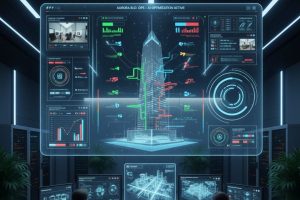Building management system lighting control is essential for any facility. Proper management is a necessity, as it boosts both comfort and operational efficiency. A building management system supports daily optimization and lowers energy consumption.
Whether it involves overseeing a small space or a complex building, implementing a building management system is critical as it can save costs, transform your facility management, and improve occupants’ experience.
What is a Building Management System (BMS)?
If you’re unfamiliar with BMS, consider it the brain of a car. It unifies and ensures proper functioning of all systems. BMS records and manages electrical and mechanical operations, including lighting, HVAC, and security.
For a moment, think of a building with a network of sensors with controls in it. What happens when these get reported to a particular system? Consider a BMS that lowers the heating or turns off the lights when a sensor detects an empty room.
The BMS gathers data such as light levels, occupancy, and temperature. It uses this information for real-time adjustments. In the case of lighting, it determines the particular time to switch off or on the lights. Furthermore, it can also adjust these light modes to suit different activities. The essence of the BMS is to ensure the building is operating efficiently for facility managers.
Knowing the different types of BMS is essential to choosing the best one for your building. Since every building and industry has different demands, BMS systems are made to accommodate several sizes and specifications. Our focus in this article is on lighting control; it is important to be conversant with other building management systems.
Understanding the Concept of Lighting Control System

There are a number of alternatives available for BMS lighting control systems, including manually operated and pre-programmed systems. In order to determine when and how much light is needed, SMART lighting controls also employ light detection technologies and motion sensors.
How Lighting System Operates
In most situations, BMS and lighting control systems are built to operate differently because BMS has been in existence for several years. Nevertheless, they are now integrated because of the introduction of luminaire-level light control systems. Lighting control uses IoT, cloud computing, and technology to function properly.
Internet of Things (IoT)
IoT technology connects different systems, often enabling them to respond to situations and data in real time. For instance, if the Building Management System (BMS) detects a spike in the national grid or if inclement weather threatens the electricity supply, the building may switch to alternative energy sources. On a hot day, for example, to reduce dependency on the external grid, the BMS might draw power from a rooftop solar system.
Additionally, a BMS might integrate sensors to detect when paper towels or soap are running low in a building. In this situation, facility managers can receive notification when to make necessary refills. These are aspect of IoT that makes the system function properly. Building management system lighting control uses IoT technologies to assess the lighting requirements of a building.
Cloud computing
Lighting control systems and BMS both generate enormous volumes of data. Facilities managers use this data for predictive analytics, scenario recreation, maintenance planning, and performance monitoring. Lighting control systems generate data to perform similar tasks. Cloud computing’s role is to provide interactive capabilities, making it easier to access and store this data.
Mobile technology
Lighting control systems also require mobile and wireless technologies, which BMS system designers and installers have adopted. With wireless luminaire-level lighting controls, light may be moved and adjusted without affecting the walls, ceiling, or floor wiring system of the building.
Additionally, mobile technology facilitates the management of many buildings, including hospitals and universities, and distant properties. Even if the BMS is located in a different building, the professionals may make changes and modifications from a central place.
Importance of BMS integration with Lighting Controls

There are several advantages to integrating lighting with a building management system. Today, most facility managers utilize building management systems (BMS), often called building automation control systems (BACS), to monitor and regulate building activities.
It allows building owners to provide the best comfort for guests while reducing energy costs. Most facility managers have realized that by centralizing monitoring and enabling intuitive device control, integrating commercial lighting with a building management system may save lighting costs by up to 30% yearly. When planning such an integration, it’s important to consider the building management system cost, which can vary based on building size, complexity, and chosen features.
Better Productivity
BMS increases other building components’ efficiency. For instance, in addition to lighting, BMS may use smart sensors for various building functions. There are new opportunities when lighting control devices are integrated with building management systems.
BMS makes it simple to implement daylight harvesting, human-centric lighting, scheduling, occupancy detection, scene creation, and other features that improve occupant comfort, convenience, productivity, and energy efficiency.
Saves Energy
When lighting and building management systems are combined, facility managers have total control over the lighting information for the building. They are able to keep an eye on how the device is functioning and optimize the energy consumption of lights and other BMS-connected equipment. This will enable them to drastically cut their energy use.
Meet target
The environmental effect of buildings must be reduced throughout time, which calls for careful assessment and constant observation. When you understand building operations, it helps maximize building performance, achieve energy efficiency, and reach net-zero goals.
Minimization of Operational Cost
Since BMS can handle all building operations from a single system, it lowers the expenses associated with training and maintaining several systems.
Why does the building management system lighting control fail
When you set up BMS and lighting controls properly, everything works efficiently. However, setting it incorrectly can cause several issues. Here are a few things that can happen with a wrong BMS and lighting control integration.
No Communication or Feedback
When using a one-way protocol such as digital serial interface (DSI), the BMS may pass an instruction without knowing whether it was successful. The system won’t be aware if a light goes out or becomes trapped, resulting in energy waste or gloomy areas.
If the BMS is unable to interact with the lighting protocol, such as attempting to utilize digital addressable lighting interface (DALI) without an appropriate gateway, the lights may not respond at all. Imagine making a command for a room to darken, and nothing occurs because the signals aren’t being sent.
Expensive Fixes
If there is a mismatch, you may need to rewire some areas of the structure or add additional hardware, such as a gateway that you did not budget for. What began as an easy setup might turn into an expensive hassle.
Energy Loss
Without adequate integration, lights may fail to adapt to daylight or remain on in unoccupied rooms, wasting power needlessly. In addition to being wasteful, it can raise energy costs and cause further problems. The assumption that all systems work well together is a major issue because they don’t. Every BMS requires the appropriate tools to deal with the peculiarities of each protocol.
Conclusion
A building’s ability to function more intelligently depends on its building management system lighting control, which is more than just a control panel. It may be connected to lighting control protocols such as Bluetooth, DSI, or DALI to increase accuracy and efficiency. Frustration and waste result from poorly executed integration. When done correctly, the building operates more efficiently, feels better, and conserves energy.





